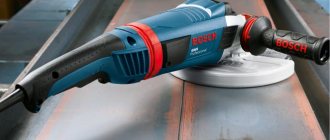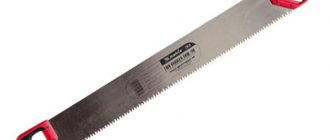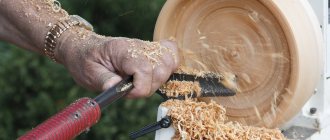A clamp, or in other words a clamp, is a must-have tool for every carpenter. The device has a simple design, but at the same time allows you to perform very important work. There are many types of clamps, each of which has a specific purpose. So that the novice master does not have difficulties, we will consider all types of clamps, their purpose and application, as well as the main criteria for choosing a quality tool.
What is a clamp and its design?
Surely many people have such a kitchen tool as a manual meat grinder. So this device is attached to the table using a clamp, which is a clamp. From this it is now clear that this device serves to fix parts in the corresponding preset position. The clamp is used mainly when carrying out carpentry and plumbing work, and is one of the mandatory tools for roofers and builders.
A clamp is also called a second hand or an assistant, which is not surprising, because this device allows the master to independently work with long beams, boards and other building materials. The main task of the device is to temporarily secure parts in the appropriate position. And the tool copes with this function best, because in addition to reliability, it is worth highlighting such an advantage of its use as ease of operation.
This is interesting!
The name clamp comes from the German word schraubzwinge.
According to the design, the clamp is a vertical base with or without a thread, which is fixed on a metal frame with a mating part.
The screw part serves not only for fixation, but also to increase or decrease pressure on the object being fixed. The devices are made primarily of metal, but wooden or plastic versions are also produced for specific purposes.
Detailed description of the clamp device
The tool is characterized by simplicity and reliability, and if you treat it with care and use it correctly, the likelihood of breakdown is reduced to zero. The principle of operation of the device is similar to that of a vice. Only, unlike heavy and large-sized devices, the clamp is lightweight, which makes it mobile, and has a lightweight design for effortless operation. The structural elements of such a device are:
- Frame - plays the role of a response element to which the part itself is directly attached. The frame part can have different types of design: G-shaped, C-shaped and T-shaped.
- Movable part - allows you to increase or decrease the distance from the working part to the frame
- Lever or screw - serves to secure the clamp in the appropriate position and makes it possible to adjust the compression force. Lever devices are equipped with a drive for quick fixation; therefore, the less force is applied, the more intense compression is obtained.
- Support heel - located on the inside of the U-shaped frame.
For more convenient movement of the threaded rod, a handle is used (can be of different types). At the end of the movable screw there is a heel, which rests against the workpiece being pressed, ensuring its reliable fixation. The pressing force depends on the physical strength that a person has.
The photo shows a clamp with the designation of its structural elements. However, such instruments are produced in different types, although their operating principle and purpose are the same. You can find out more about what a clamp is used for in the next section.
Purpose and use of hand clamps
A wide variety of tools allows each master to choose the most suitable option for performing the relevant work. The use of clamps is not limited to any areas, but most often they are used for the following purposes:
- Sheet metal clamp - the design consists of a steel body, handle and clamping mechanism, the basis of which is a spring. Clamps of this type are especially popular in warehouses, manufacturing and other industries.
- Furniture assembly - it is impossible to imagine the furniture-making industry without a tool such as a clamp. Here this device is used for pressing elements to be glued together, as well as for temporary fixation of load-bearing structures of various furniture.
- Making formwork - the clamp plays the role of a load-bearing element, due to which the wooden supports are fixed.
- Laying laminate flooring - when working with flooring, it becomes necessary to fix building materials. The quality of installation depends on the use of a clamp when working with laminate.
- Installation of ventilation - special types of clamps are used, which are called beam clamps. They are also used when laying various utilities, which are used to secure fasteners to load-bearing structures. The advantage of using beam clamps is that there is no need for drilling or welding, which not only facilitates but also speeds up the process.
- Installation of suspended ceilings - for such purposes, clamps are used that have a pincer-like design. They are made of plastic, and they are available with different grips of 100, 150 and 200 mm. A clamp is used to hang the canvas before it is heated. To install a stretch ceiling, at least 6 clamps are required.
The scope of use of the clamp is not limited, which is due to the versatility of this device. Fixing various parts (from small to large) cannot be done without the use of such an indispensable device as a clamp.
What size clamps are there?
One of the main technical parameters of clamps is their size. They come in small and large, long and short, but these words mean nothing, so below are the facts:
- The length of the clamps ranges from 150 to 900 mm. Larger devices are also available, but they are used primarily in production.
- Width: from 120 to 350 mm.
- Another important parameter is the size of the working area - in other words, this criterion indicates the maximum opening of the moving part. This distance depends directly on the size of the clamp, and varies in the range from 10 to 600 mm.
Corner clamps have a minimum grip, the size of which ranges from 10 to 100 mm. The reason for such a small grip is that the contact is made at a right angle of 90 degrees.
F-type clamps have the maximum operating range. It ranges from 15 to 350 mm with a tool length of 400 mm. The G-shaped clamp belongs to the category of medium-sized devices, the grip of which varies from 70 to 170 mm.
Clamp size chart
The size of the clamp is one of the main criteria for these tools. This is what you should consider first when purchasing a device.
Using the tool, types and its structure
There are no clamps that would one hundred percent meet our needs when carrying out work around the house. Clamps come in different shapes, models and sizes. As a rule, there are not enough of them. Below is a short list of devices for solving assigned tasks in wood and metal processing:
- wooden;
- metal;
- F-shaped;
- C-shaped;
- corner;
- cam;
- G-shaped;
- wire clamps;
- ribbon clips.
Making a clamp yourself is quite simple. Of course, when carrying out work, this is not a tool that is constantly needed. But it doesn't hurt to always have it on hand.
Material for making hand clamps and what it affects
In most cases, metal is used to make a clamp. However, there are also products made of wood or plastic. What are the features of each type of material for the production of clamps, we will find out further.
- Forged cast iron - their main advantages include such properties as durability, strength and reliability. F-shaped clamps with a screw clamp are made from cast iron. Their main difference is their high cost.
- Made of plastic - used to work with any types of materials except metal. Most often they are used when installing suspended ceilings or gluing rubber, plastic and other parts. They are made from polymers that are resistant to mechanical stress.
- Metal stamped ones are the most common type of clamps that most craftsmen choose. They are used for various purposes, but their main purpose is the installation of metal frame and load-bearing structures. To resist corrosion, metal surfaces are coated with zinc or galvanic substances.
- Wooden - they are designed to work with fragile and soft materials, including wood products. The main condition for their manufacture is the use of hard wood, which eliminates the possibility of failure during operation.
- They are made from aluminum - they are produced by casting, and the main advantages of such devices include: lightness, corrosion resistance and low price. It is very important to take into account that such models are not intended for use under intense loads.
There are also clamps made of various metal alloys, but such tools are not reliable. They are manufactured in China and supplied to Russia, Ukraine, and Belarus. Many craftsmen prefer to choose these types of clamps, because in appearance they do not differ from products made of cast iron or stamped metal, and they captivate with their affordable price.
This is interesting! If you choose a clamp from a Chinese manufacturer, it is important to take into account that under the influence of intense loads it may fail. As a result, the master will lose not only the tool, bought at a low price, but most importantly, he risks his safety.
Types of clamps according to their design
An auxiliary tool is used to fix various parts and objects. Clamping can be performed temporarily or permanently, which the device also copes with quite effectively. The clamp allows you to fix the part in the required position with its preliminary alignment to ensure better fastening of the parts. Subsequent fixation of parts can be done using glue, self-tapping screws, bolts, or welding joints. Depending on the type of work performed, the following types of clamps are used:
- G-shaped - a fastening tool, the main purpose of which is to work with metal workpieces. The design is called G-shaped due to its resemblance to the letter G. Tool steel is used to manufacture the product, which has a positive effect on the strength properties of the device. The shape of the tool plays an important role, since thanks to this design, the clamp is resistant to deformation. High-quality clamping of the workpiece is achieved due to the fine pitch of the thread on the screw. The only disadvantage of small threads is the time required to fix the workpiece. Clamps of this shape are suitable for working not only with metal, but also with wood. An analogue of G-shaped clamps are C-shaped ones, which are characterized by the absence of a protrusion on the fixed heel.
- End clamps are the name given to clamps that are used to secure workpieces from the end side. The devices are a standard clamp, which is equipped with one fixed and two movable clamps, which are located perpendicular to each other. Such devices are especially popular in furniture manufacturing, since they are used to secure furniture overlays to the end side.
- T-shaped - they consist of a base with guides for the movable jaws of the tool. One jaw is rigidly fixed to the base with a metal stopper, and the second is moved using a threaded screw. This type of tool is used for installing window frames, as well as for fixing workpieces with their subsequent processing. The length of such devices can reach 1 meter, so they can easily replace a conventional vice.
- F-shaped - a simplified version of T-shaped models. The main advantages of such devices are a wide range of adjustments and tool mobility. However, this type of tool has a drawback, which manifests itself in the form of reduced reliability, which is due to a large range of adjustments. The components of F-shaped clamps are: a metal strip with a fixed and also a movable jaw. The latter moves along the guide, which allows you to work with workpieces of different sizes. With their help you can fix a large number of workpieces.
- Corner - they are used to combine parts at different angles. Devices are classified into magnetic and screw. If the first type is used primarily for working with metal workpieces, then various wood workpieces are connected with screws. Such devices consist of a body with two pressure heels located relative to each other at a right angle of 90 degrees.
- Band clamps - carpenters actively use band clamps, which consist of wooden or metal clamps placed on a belt. Clamps in an amount of 4 pieces are pre-installed on the structure, and they are pressed and secured with a belt. Such devices are used in the assembly and manufacture of furniture, facilitating the work process.
- Pipe - they are called so not because of the purpose of working with pipes, but because the basis of their design is a pipe. They look like a classic clamp, only a tube is used as the base. One heel is fixed, and the second is adjusted by moving along the pipe, and is clamped using a screw clamp. The main area of application of such devices is in the furniture industry for gluing panels in the manufacture of countertops and doors. The main advantage is the ability to work with large-sized workpieces. These devices are based on pipes, since they are the ones that make it possible to achieve such high reliability and durability of the tool.
- Spring pliers are pliers with handles, with the help of which the clamping jaws are driven. One jaw has a rigid fastening, and the second can be adjusted depending on the size of the workpiece being clamped.
Having an idea of the types of clamps, it will not be difficult to choose them depending on the planned work. However, size, material and design are not all the parameters by which clamps are classified. When choosing a clamp, you need to take into account the peculiarities of their functioning, so next we will consider what they are based on their operating principle.
Angle clamps
Next up is a category intended for highly focused work. A corner clamp may be needed if it is necessary to bring the corners together on any structure. The general principle of this design involves two separate modules, each of which acts on its own plane, shifting the part at an angle.
FIT 59275 72 mm
Many experts believe that this is the best clamp for universal work. It allows you to comfortably work with wood and metal, and even glass. As in the previous case, all parts are made of steel. There are no plastic parts here. This means that you can use the tool to perform welding work.
If desired, you can securely fasten the tool to a plane. This is done using special holes. Thus, the use prevents the risk of the structure falling along with a massive object.
Pros:
- The body is made of aluminum;
- Low cost up to 250 rubles;
- Light weight – 150 grams;
- The impressive width of the clamp allows you to work with thick beams and massive metal objects;
- Powder coating;
- You can keep two parts in the same plane;
- The screws are made of stainless steel;
- Small size for increased mobility. Easy to transport. Dimensions are 24 by 10 by 2 centimeters.
Minuses:
- A slight play is observed on the jaws;
- The handles are too thin and unreliable for turning the screws. Inconvenient and can quickly bend;
- Poor quality retaining ring;
- The case is too thin.
The best quick-release clamp BAHCO QCB-900
Next up is an excellent tool that allows you to reliably fix even a huge object in 1 second. Clamping occurs by pressing the trigger. The user doesn't even need to make any special efforts. This model is manufactured in Switzerland, and therefore has excellent quality, reliability and efficiency.
The handle has a rubber surface, which makes it comfortable to grip and pull the trigger. The jaws have special pads that increase the clamping area, thereby increasing its efficiency. The size can be quickly changed using a special button.
Pros:
- Very comfortable handle;
- Easy to clamp. All you have to do is pull the trigger;
- Reliable assembly from high-quality parts;
- The trigger is easy to pull;
- The clamping depth is almost 10 centimeters;
- The clamp width is 90 cm. This is the largest indicator;
- The rail has a thick structure and is made of durable metal. This prevents the possibility of bending;
- The trigger is stretched across the entire handle. This improves comfort and prevents finger pinching;
- You can work with wood, as there are overlays.
Minuses:
- Extremely high cost compared to other models. You can reach 2 thousand rubles;
- After a long period of use, rust may appear if the device is exposed to moisture;
- Large dimensions. Difficult to transport;
- Large mass.
Pipe clamp Enkor 20079 3/4”
It remains to consider only the pipe version of the clamp. They are used for processing pipes that need to be quickly pulled together. The design consists of two main modules. One part is motionless and consists of several rings. They need to be put on the pipe and secured tightly. After this, the wizard works with the second module, which is needed for tightening.
Model Enkor 20079 is ideal for gluing panels and other wooden structures. Most often, this model is used by welders and carpenters. The screw stroke is 7 centimeters.
Pros:
- Wide thread pitch;
- Powder coated against corrosion;
- You can choose the length of the slats yourself;
- No plastic parts. Consists of metal.
Minuses:
- Price tag from 700 rubles;
- Can only be used with a pipe whose diameter is 3/4;
- The pipe must be purchased separately from the clamp.
Types of clamps based on operating principle
The most popular type of clamps are classic ones, they have a mechanical operating principle. This is when the devices are operated by hand. They are called manual or mechanical clamps, which are equipped with a screw element with a heel, which are driven by a handle. In addition to mechanical ones, there are also other types of clamps, which will be useful to know about for everyone who chooses a device for the corresponding work.
- Magnetic is a popular type of tool for electric welders. They allow you to temporarily connect two parts at right angles in order to subsequently weld them. Structurally, the device is a polyhedron with right angles. Inside the metal case there are magnets that are magnetized to metal structures.
- Automatic - they are also called pistol, rack and pinion and trigger. The devices have an F-shaped design, and consist of a base with guides for moving the movable jaw. When you press the trigger, the movable jaw is securely fixed, providing high-quality and reliable clamping of the part.
- Hydraulic and pneumatic (vacuum) - the operating principle of such devices is similar, only the first type of clamp uses oil liquid, and the second uses compressed air. Such devices are distinguished by their special reliability and clamping strength, which is why they are used when working with glass, artificial stone and ceramics. The basis of such clamps are chambers in which the required force is pumped.
Ratchet clamps are also produced that look like pliers. The basis of such a tool is a mechanism called a ratchet, which is used to perform high-quality clamping. To ease the compression, the design provides a special pawl.
From all that has been said above, it should be noted that knowing all the main types of clamps, it will not be difficult to choose the appropriate model for the job. However, there are certain recommendations on the basis of which you can choose a clamp and use it not only for its intended purpose.
Choosing a clamp for the home and garage: criteria and recommendations
Choosing a clamping tool, even for a professional craftsman, can raise a lot of questions, let alone for beginners. When visiting a modern hardware store, you may encounter a wide variety of types of clamps that are designed to solve specific problems. And in order to solve these problems as correctly as possible, you should take a responsible approach to the process of choosing a clamp. Experts recommend taking into account the following criteria:
- Workpiece fixation mechanism - the most popular are models equipped with screw clamps. They are practical, convenient and inexpensive. When choosing a clamp with a threaded mechanism, it is recommended to give preference to models with a movable jaw. Their advantage is that they allow you to work with workpieces of any size.
- Clamping force is another very important parameter, because not only the quality and speed of work, but also safety depends on it. This parameter depends directly on the type of tool used, and can vary from 20 kg to 1 ton. Maximum force is naturally provided by hydraulic and vacuum clamps.
- The presence of auxiliary elements - with the help of a clamp you can not only compress workpieces, thereby ensuring their temporary connection, but also use it as a spacer tool. This option in the device will definitely not be superfluous.
- Weight - the heavier the tool, the more difficult it is to operate. The weight of the device is influenced by factors such as the size of the tool and the material from which it is made. The heaviest ones are cast iron and steel, while the light ones are made of wood, aluminum and plastic. When choosing a tool by weight, it is also worth considering that the smaller the mass, the correspondingly lower its reliability and strength.
Quick clamp design - Susceptibility to corrosion - the metal parts of the clamps are protected with paint or a special zinc coating, which allows you to increase the service life of the tool. Electroplated units are more expensive than painted ones.
- Additional accessories - to increase the convenience of working with clamps, many manufacturers equip them with various elements. One of these elements is a T-shaped handle, the main purpose of which is to adjust the clamping force. Rubber pads are attached to the jaws, which prevent damage to the surface of the clamped parts. When working with metal parts, such overlays also play an important role. Their absence will not entail deformation of the metal blanks, but the possibility of their displacement cannot be excluded.
Although a clamp is a multifunctional clamping tool, when using it it is necessary to take into account the operating conditions; for example, it is not recommended to use a plastic tool with metal workpieces. If you are a self-respecting craftsman, you should definitely have at least five types of clamps at your disposal.
Manufacturers of clamps
One of the important criteria for choosing tools is the reputation of the manufacturer. We have selected brands whose products you can trust:
- Gross is a manufacturer that is part of the Russian concern “World of Instrument”. Offers high-tech products made at a professional level. The company's catalog has a large selection of carpentry, plumbing, measuring and other tools.
- Zubr is a company that appeared only in 2005, but has already established itself thanks to its high-quality, reliable products. The brand's equipment can be trusted with the most complex tasks.
- Kraftool is a German manufacturer of professional construction tools for various tasks. The company's products are famous for their ergonomics, stylish design, and durability.
- Fit or Finch Industrial Tools is a Canadian company that produces hand and power tools for professional or home use. The brand was born in 1996, today it is one of the largest players in the global market.
- Stanley is a brand known since 1843. The American manufacturer quickly gained recognition due to the high quality of its products. This logo sells reliable manual or electric construction equipment made from durable materials, which are distinguished by well-thought-out ergonomics and high performance.
- Cobalt is a Russian brand that makes assembly and plumbing equipment. The company follows three main principles: reliability, ergonomics, optimal price.
- Matrix is a German manufacturer whose product range includes more than 3,000 items. Here you can find everything from fasteners to plumbing equipment or automotive tools.
- Sparta - produces accessories for home or car repairs. They are known for their low prices and are in demand among thrifty buyers who do not often resort to construction work.
- Santool is a company that has been selling hand-held construction tools since 2004. The main advantage of its products is a reasonable combination of price and quality. The brand's products are intended for personal use, but are also in demand in small workshops.
- Sibrtech is a brand that makes a simple, reliable, inexpensive tool. The name combines two words – Siberia and Technology. Laconic design and the absence of unnecessary bells and whistles are the main differences between the brand’s products. Sibrtech products are designed to help with home or car repairs.
Band clamp - everything you need to know about the tool
One of the most little-known types of clamps is the band clamp. Very often, novice craftsmen wonder about the design of this tool and its operating principle. Let's look at this issue in more detail.
A tape clamp is a tool that is based on a nylon tape, belt or cable. Unlike classic models, these clamp options are designed to work with round, triangular and other geometric shapes. The devices have a simple design and operating principle. The tape acts as a clamp, and special plastic or metal corners are used as clamps.
This type of tool is used when working with furniture, and also allows you to glue aquariums, make window frames and picture frames. When choosing such a device, you should specify the length of the tape, since it determines what size parts can be compressed.
This is interesting! You can make a tape clamp with your own hands. To do this you will need a steel cable, angles and a housing with a clamping mechanism. Making a tool with your own hands is not difficult, so if you need it, then based on the video, you can realize your idea.
Making a clamp with your own hands from improvised means
The clamp has a very simple design, so every craftsman probably had the idea of making the device himself, using available tools. If yes, then below are instructions on how to make a clamp with your own hands.
First, let's figure out what can be used to make the device. The following types of consumables are suitable for this:
- profile pipe;
- thick plywood;
- old bearings;
- meat grinder;
- round pipe;
- fittings
You can make a homemade tool from any parts, having previously thought through its design. In this material we will look at several types of clamps made by ourselves. The easiest way to make a clamp is to use wooden blocks, but such a device is only suitable for working with wooden products. This is why many people prefer to make clamps from metal.
How to do which
Any of the clamps described above can be made independently in a home workshop. Carpentry clamps are made of metal - the wooden frame and jaws of the tool will not withstand the back pressure of the material of the part(s), the clamp will weaken during operation, and the clamp itself will become unusable. With welded and soldered clamps it’s already clear: only metal; wood is a flammable material.
Carpentry clamps for working with valuable wood or products are best made of wood, but you can also use metal ones with spacers made of plywood or even shingles. It is better to use wooden clamps for gluing into a layer (on thick workpieces from several thin ones), even if metal or plastic is being glued - wooden jaws provide a more uniform distribution of pressure over the plane and, accordingly, better gluing quality. Fragile parts (glass, etc.) are compressed for gluing only with wooden clamps.
Do-it-yourself metal clamp from improvised means
When making a metal clamp, it is almost impossible to do without a welding machine and an angle grinder. You can use a steel pipe as a base, resulting in a tubular clamp. Any steel blanks that every craftsman probably has at his disposal will also be suitable. Let's look at the features of making a clamp from a metal pipe measuring 100×100 mm and at least 3-4 mm thick. The instructions look like this:
- We cut off a 2 cm piece from the pipe and get a steel square.
- Next, we cut the square in half, and we get two almost finished clamps. It is very important to take into account here that if you cut a square in half, then you can clamp workpieces in the tool that are limited in size. That is why you can cut off a little more so that there is a reserve.
- The next step is to cut a hole at the end into which the movable jaw will be attached. The size of the hole depends on the diameter of the bolt used. It’s better not to save money and take a bolt 10-12 mm thick.
- Next, prepare the bolt and nut. The length of the bolt should be such that it is sufficient to touch the opposite part of the workpiece. If the length of the workpiece is 10 cm, then the length of the bolt must be at least 15 cm.
- We attach the bolt and nut to the plate and align it perpendicular to the base. The nut is welded to the plastic.
- The clamp is almost ready for use. To make it easier to rotate the bolt, it is necessary to weld a piece of electrode perpendicular to the leg.
- The length of the welded electrode affects the force, therefore, the larger its size, the less force will have to be applied to clamp the part. If you want to get a clamp that will be as similar as possible to the factory model, then a hole is drilled in the bolt leg and a piece of electrode is installed.
When choosing a workpiece for making a tool, it is important to consider the thickness of the steel. The reliability and efficiency of a homemade device will depend on this factor. In fact, such a metal clamp is not inferior to factory analogues. By devoting just a couple of hours of time, you can get a high-quality tool with minimal financial costs. The video below shows the tool in action.
Carpenter's pliers
Wooden temporary clamps are used in carpentry as widely as steel ones in plumbing and welding. Due to the characteristics of the main structural material, carpentry clamps are made almost exclusively C-shaped (pincer clamps).
The most powerful of the carpentry clamping devices is the alligator clamp, pos. 1 in Fig.:
Types of carpentry clamps
Sponges made of oak, elm, beech, hornbeam, walnut. Threaded pairs – from M12. Clamping parts with a crocodile is a troublesome task, so instead they often use an articulated screw C-clamp, pos. 2. Its “jaws” can be glued from plywood, and only the lining (“lips”) can be glued from durable wood. Instead of a shaped nut, it is possible to use a regular hexagonal nut, pressing it into the handle in a vice; in this case, the handle should be made of maple, beech or elm; oak may split when pressed.
Alligator clamps are used to securely hold fairly large and heavy parts. When gluing, you don’t need a strong clamp, but you need a lot of clamps, at least 3-4 per 1 linear meter. m glue joint. Therefore, carpentry clamps for gluing are most often made of plywood. Each “jaw” is glued together from 3 or another odd number of layers. In one of the “jaws” with a protrusion there will be a middle layer, and in the opposite one there will be two outer ones; In this way, and with the help of a steel pin, a hinge is formed. The clamp is spring (pos. 3 in the figure), and made from available elastic materials, pos. 4.
Cutting out and adjusting blanks of plywood crocodile clamps is a labor-intensive task, but the modern craftsman has at his disposal an excellent substitute - cuttings of large-diameter PVC pipes. A split ring made of pipe, a pair of wooden sticks, the same number of pieces of garden hose, and a clamp for pressing when gluing is ready, pos. 5. Cheap and cheerful. For more information about wooden clamps, see the videos:
Video: DIY wooden clamps
For the second, we advise you to go to YouTube and read the comments, there are tips on the case.
Instructions for making a wooden clamp: detailed description
With a minimal set of tools, you can make a wood clamp. For this you will need:
- two wooden blocks measuring 50x50 mm;
- several long bolts or studs with nuts and washers;
- The only tool you need is a drill.
Let's start creating a tool with our own hands. We cut out two blanks from bars 25 cm long. These will be the jaws of the future tool. Further actions are presented in the list:
- The bars must be pre-treated with sandpaper and varnished to give the instrument an aesthetic appearance.
- Take studs with a diameter of 8 mm and a length of 20 cm with nuts and washers, and drill holes for them in the blanks.
- Drill holes at a distance of 5-8 cm from each other, as shown in the photo.
- Assemble the tool using nuts and washers. The photo below shows a homemade wooden clamp, which took no more than 20 minutes to make.
The resulting tool is recommended to be used exclusively for working with wooden workpieces or sheet steel. The video below describes the process of making the tool and also demonstrates its effectiveness in use.
Below are photos of various options for making clamps with your own hands. Using them as a basis for your ideas, it will not be difficult to turn them into reality.
- This model is based on stainless steel. For manufacturing you will need semi-automatic welding.
- The clamp is made of steel. Its advantage is that the fixed foot can move, expanding the capabilities of the tool.
- If you have a steel profile and a welding machine, then making a simple clamp will not be difficult.
- This model is based on round tubes to which heels and wide nuts are welded.
- This tool is based on round metal pipes.
The advantage of the clamp is that it has a simple design. If you have an unnecessary manual meat grinder, then by cutting off the top part of it, you can get a finished tool. Due to their simplicity, clamps can be made from almost anything, the main thing is that the device has sufficient reliability, since human safety depends on its quality and serviceability.
How to make a carpenter's clamp
In carpentry, one of the most common operations is gluing wooden blocks at right angles. While the glue dries, the bars must be firmly fixed in a certain position. This problem is solved by a special carpentry clamp. Between two mutually perpendicular jaws there is a movable rectangular part. This combination firmly fixes the boards in a given position.
PHOTO: instrumentn.ru Corner clamp for carpentry work
The end clamp also belongs to carpentry. It serves to hold down the decorative strip while gluing it to the furniture board (table top).
PHOTO: woodschool.ru End carpentry clamp
Materials and tools
The corner clamp is difficult to make with your own hands, but it is very helpful in carpentry work. And doing it yourself is the most interesting thing. The device can be made of metal or wood. The latter option is more accessible for self-production.
Wooden blocks with a cross section of 40×40 mm² are used as the material for the structure. For the base platform, take a piece of plywood 15-20 mm thick and 350x350 mm² in size. The clamping mechanism will require two steel pins with a diameter of 15-18 mm and a length of approximately 200 mm. It is necessary to select appropriate nuts for the studs with the ability to fix them in the wood.
PHOTO: rmnt.ru Corner carpentry clamp
Manufacturing instructions
In one of the corners of the platform, two bars are firmly screwed to one another at 90º. They form a standard right angle. At a distance from these main support bars, two more bars are attached parallel to them. The distance should be approximately 30 mm greater than the thickness of the parts intended for gluing. In these new parts, the running nuts are fixed in the middle. There will be pins going through them, onto the outer ends of which it is advisable to attach handles for ease of operation.
Movable blocks are installed at their inner ends. The ends of the pins in these bars should rotate freely, but at the same time create a pressure force. A blind hole should be drilled in the movable bar, the depth of which is equal to half its thickness, a blind washer should be pressed into the bottom, and a bearing (not necessarily ball) should be pressed into the hole, in which the thrust end of the pin will rotate.
The parts to be glued are placed on the top of the reference angle and pressed against fixed stops with movable bars.











